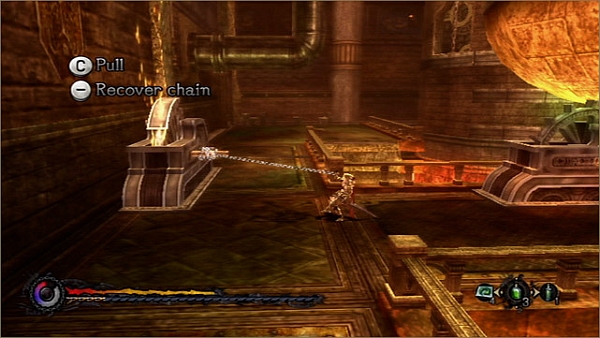
Pandora’s Tower is the third game published by Nintendo in Japan that has made it to North America thanks to the activist efforts of Operation Rainfall. It is also the one I was most excited for of the three. The strange, beautiful trailers filtering here from Japan intrigued me, and the combat system looked refreshing and different. While the graphics are limited on the Wii, the strength of both the gameplay and the narrative drew me in. When I finally played the game, it was even weirder than I’d expected, but even with the weaknesses, I felt my 25 hours were well spent.
Platforms: Wii
Publisher: XSEED Games
Developer: Ganbarion
Genre: Wrist-Killing Action RPG
Release Date: April 16, 2013
ESRB Rating: Teen
The game throws you right into the action, delivering Elena’s fate in the opening cutscene. She turns into a beast while singing at a festival for the city, and her boyfriend, Aeron, rescues her and runs from the authorities. A strange woman named Mavda, who is carrying what appears to be an absurd, mostly skeletal man who talks in nonsense, helps them escape the city and takes them to a great fortress that holds the thirteen towers. These towers are suspended over a giant chasm, called the Scar, by chains. The bizarre party holes up in the Observatory, and here is where the game actually begins.
In these early scenes, you learn from Mavda that Elena has been cursed – that she will eventually turn into a beast, and the only way to stop this from happening is to feed her the flesh of the Master in each tower. Beyond the disturbing implications of eating raw monster flesh, Elena is a vegetarian, and has never had meat in her life. So the fact that she must eat the raw flesh of these beasts is a bit unsettling.
Aeron is armed with a sword as well as a chain, given to him by Mavda. The chain plays an important role in the game – not only can it be used to attack enemies, it can also be used to tie them up, chain them together for combo hits, unlock doors, climb walls, and get to grapple points you can then swing from. It’s also the only thing that can remove the flesh from the Masters, and often the only weapon effective against them at all. The chain also connects Aeron and Elena to one another – in the bottom left-hand corner of the screen is a timer that shows you how far along Elena is in her metamorphosis. Bringing her the flesh of lesser beasts will keep the curse at bay, but according to Mavda, the only real cure is feeding her the Master flesh.
There’s a deep and meaningful relationship here – at least, the beauty is inferred by Aeron’s actions. He is risking his life to save this girl, one who – you learn from cutscenes – once saved his. They have grown to love one another, and Aeron will do anything to save her. But the problem is that, while inherently embedded in the story, the actual relationship between the two has no depth whatsoever. Anything you apply to them is developed through your own imagination – we’re given no real backstory for either character, and other than showing her nursing him back to health after she finds him wounded, there’s nothing given about their relationship.
As you go from tower to tower, you learn the truth behind the Masters, and what kind of strange experiments were being conducted here. The Masters themselves were locked in the towers so that no one could release them, so you must find and break each chain binding them. The chains multiply as you progress further into the game, and the incredible combination of action-RPG fighting style, timed platforming, and puzzle-solving can be intensely challenging. Pandora’s Tower is not easy, and harkens back to a time when games were more challenging – when gamers were rewarded for searching every nook and cranny, and for testing out switches and mechanisms.
But the shining moments in Pandora’s Tower were by far the battles against the Masters themselves. Rivaling Shadow of the Colossus in complexity and need for skill, some of these beasts will leave you breathless. The puzzle of each is figuring out exactly how to kill them, and once you’ve got the idea down, the game throws more curveballs at you. Did you finally time the attack to get the monster’s health down? Now he’s going to add another attack into the mix, one that stuns you. Getting them down to half health nearly always throws them into a rage, making them more aggressive with attacks that are harder to dodge.

As you defeat each Master, you bring the flesh to Elena, who then has a brief respite from the curse – just enough time for you to go out and do it all over again. In these moments you spend at the Observatory, there’s much you can do – you can chat with her, ask her to translate texts you’ve found that you can’t read, give her gifts (that you buy from Mavda, oddly enough), rest up and regain health points (being in close proximity to Elena means her monster counter stays at zero), or deal with Mavda, who is like a shopkeeper, smith, and town gossip, all in one.
The game has a lot going on with the inventory. You can find items all over the place, many of which can be brought to Mavda to craft things. You can also buy items from and sell items to her, upgrade your weapons, repair broken items, and talk to her about various things. The chat option really only lets you hear about what’s going on in the outside world, and get advice about the tower you’re starting next. She is mostly just a creepy, weird old lady, who is vague and just a little threatening.
I loved playing Pandora’s Tower, even with my gripes about the story and the characters. The gameplay, while occasionally tedious, was refreshingly difficult and rewarded curiosity. Going from room to room, fighting monsters and trying to figure out how to get to the chain rooms to bust the connectors and open up the doors to the Master’s chambers, working out puzzles that grow richer with each tower – all of it was so rewarding that it almost didn’t matter how one-dimensional the story was.
My biggest gripe about the game was that I’ve never had such an amazing final boss battle be followed by such a disappointing cutscene. There are multiple endings to the game, depending on how you treated Elena (I treated her as nicely as possible, given that she was my girlfriend and I was, you know, putting all this effort into trying to save her). The ending I got was too short, too vague, and answered none of the questions I had. The good news is that beating the game unlocks New Game+, which gives you access to doors that were previously locked, as well as the chance to make different decisions and see the other endings.
Pandora’s Tower is the best game I’ve played on the Wii, and as hackneyed as the term is, it is the swan song of the system. If your Wii is gathering dust and you’re dying to get your hands on a great JRPG, you should definitely pick it up. It’s a strange journey, reminiscent of both Ico and Shadow of the Colossus in its great scale of loneliness. Even if you don’t feel an attachment for the characters, there’s still much to gain here, and a great experience to be had.

Review Disclosure: A retail copy of Pandora’s Tower was purchased by Warp Zoned for the purposes of this review.






